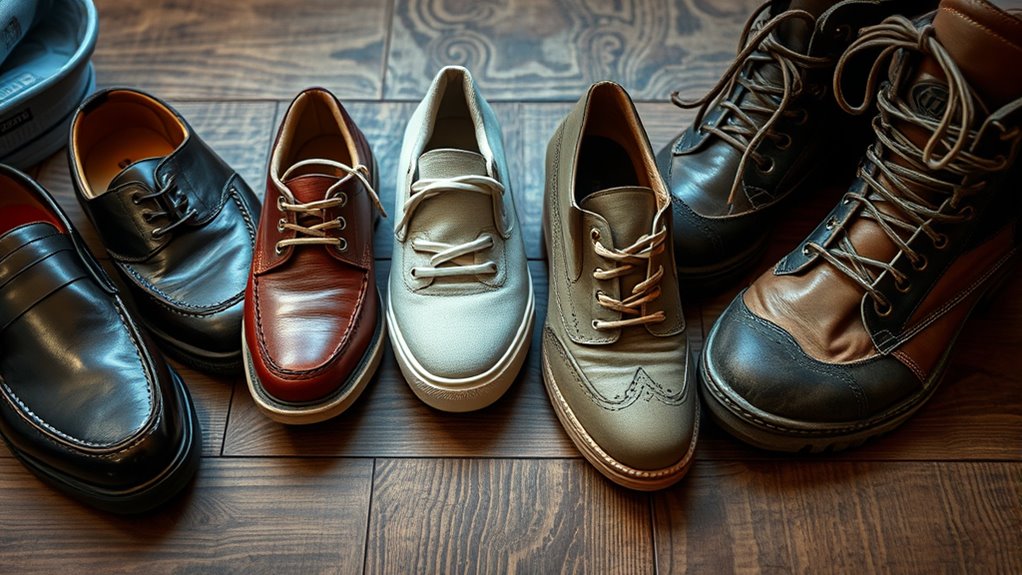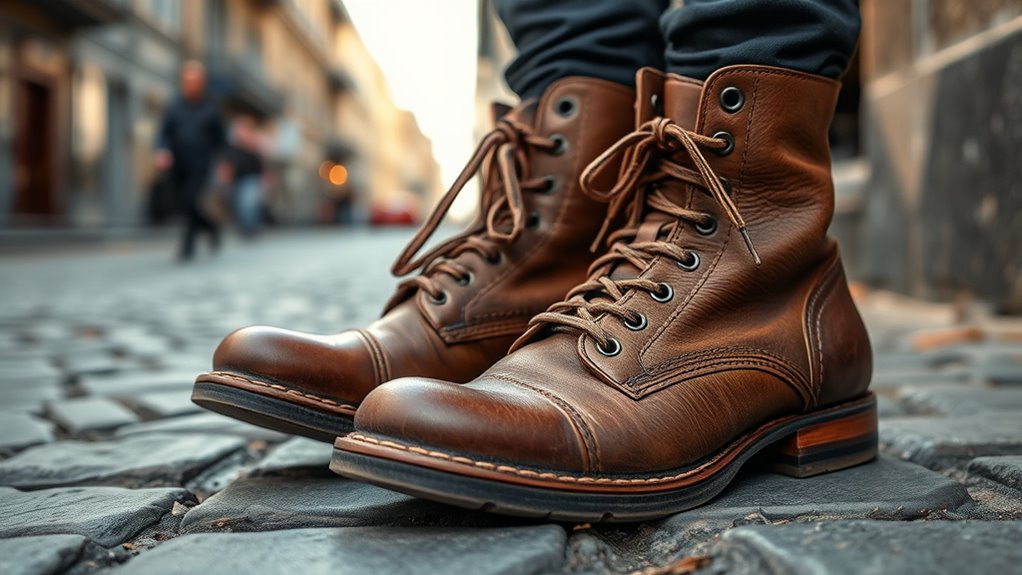Your shoes reveal more about your beliefs, culture, and social role than you might think. Different styles and colors can symbolize personality traits, social status, or even superstitions—like giving new shoes for luck or leaving them outside to ward off spirits. Footwear can also mark traditions, show respect, or express identity. A closer look at your shoes uncovers stories and messages you might not realize you’re telling. Keep exploring to discover what your footwear truly says about you.
Key Takeaways
- Shoes can indicate social status, profession, or personal identity through style, color, and condition.
- Certain footwear superstitions, like giving or leaving shoes outside, convey beliefs about luck and protection.
- Cultural symbolism in shoes reflects spiritual beliefs, rituals, and traditional values across societies.
- Specific shoe types, such as wedding or ceremonial shoes, symbolize new beginnings, respect, or cultural stories.
- The condition and style of shoes often reveal personality traits, social roles, or emotional states.

Have you ever wondered why certain shoes are associated with specific superstitions or stories? It’s because footwear carries more than just practical use; it’s embedded with cultural significance, superstitions, and symbolism that reflect our beliefs, history, and social values. Throughout history, different cultures have attributed meanings to various types of shoes, turning them into symbols that convey messages beyond mere fashion. For example, in some societies, wearing certain shoes can symbolize status or wealth, while in others, they might serve as talismans to ward off evil spirits or bring good luck.
Footwear reflects cultural stories, superstitions, and symbols that convey deeper social and spiritual meanings beyond fashion.
Superstitions linked to footwear often stem from deep-rooted beliefs and stories passed down through generations. For instance, stepping over someone’s shoes was once believed to be a way of blocking their luck or success, rooted in the idea that shoes represented one’s journey or path in life. Conversely, giving someone a new pair of shoes was considered a gesture offering protection or prosperity. In some cultures, leaving shoes outside the house or on the doorstep is thought to prevent bad spirits from entering. These superstitions reveal a common theme: shoes are seen as more than just objects—they’re symbols that connect us to unseen forces and cultural narratives.
The symbolism of shoes can also reflect societal roles or personal identity. For example, in many cultures, specific footwear indicates social standing or profession. A pair of polished loafers might signify professionalism, while worn-out sneakers could suggest casualness or youth. In some traditions, shoes are part of ceremonial attire, representing respect, tradition, or spiritual connection. The color, style, and condition of shoes often communicate subtle messages about who you are or what you believe. Wearing red shoes, for example, might symbolize passion or confidence, whereas plain black shoes could imply formality or humility.
Understanding the cultural significance behind shoes allows you to see their deeper meaning in social interactions and rituals. Whether it’s a bride’s white wedding shoes symbolizing purity or a warrior’s sturdy boots representing strength, footwear embodies stories, values, and beliefs. These symbols can influence how others perceive you without you saying a word. Recognizing superstitions and symbolism connected to shoes can also make you more mindful of the stories you wear and the messages your footwear might send. Shoes are powerful symbols that carry history, emotion, and cultural identity—so next time you slip on your favorite pair, remember, they might be telling a story about you too. Additionally, the use of affiliate links to purchase shoes or accessories can influence perceptions and choices based on these cultural meanings.
Frequently Asked Questions
Do Different Shoe Colors Have Specific Meanings?
You might wonder if shoe colors carry specific meanings. In color symbolism and shade psychology, different hues can reflect your personality or mood. For example, red shoes often signal confidence and passion, while blue shades suggest calmness and trustworthiness. Bright colors grab attention, whereas neutral shades convey sophistication. So, yes, your choice of shoe color can subtly communicate your feelings or style, making your footwear a silent yet powerful statement.
How Do Shoe Styles Vary Across Cultures?
Imagine walking through a vibrant tapestry of cultural footwear traditions, each style whispering regional shoe symbolism. Across the world, you’ll notice that shoe styles vary greatly—traditional embroidered slippers in the Middle East, ornate wooden clogs in Scandinavia, or sleek sneakers in urban America. These regional variations reflect cultural histories, social customs, and artistic expressions, showing how footwear acts as a silent language that connects you to diverse cultural identities.
Can Footwear Choices Influence First Impressions?
Your footwear choices definitely influence first impressions. When you wear comfortable shoes, you appear more confident and approachable, while durable footwear suggests reliability. People notice shoe comfort and footwear durability, which can impact how they perceive you in professional or social settings. Choosing shoes that reflect your personality and occasion helps you make a positive impression, showing you’re attentive to detail and value both comfort and quality.
Are There Any Superstitions About Shoe Placement?
You might wonder if there are shoe placement rituals rooted in footwear superstition symbols. Many believe that specific shoe placements can influence luck or ward off bad energy. For example, some follow rituals like placing shoes facing a certain direction or leaving them in particular spots to attract positive vibes. These shoe placement rituals are steeped in footwear superstition symbols, reflecting cultural beliefs about luck, protection, and harmony.
How Do Footwear Trends Reflect Societal Changes?
You see footwear trends mirror societal shifts, like sneaker culture’s rise highlighting youth and innovation. Eco-friendly footwear reflects growing environmental awareness, showing your values and concern for sustainability. As fashion evolves, you adapt by choosing styles that represent your identity and beliefs. These trends reveal how society prioritizes comfort, sustainability, and self-expression, making your footwear choices a reflection of broader cultural changes and your personal stance in a changing world.
Conclusion
Now that you know what your shoes say about you, it’s clear they’re more than just fashion statements. Your footwear can reveal your personality, mood, and even your future. Remember, don’t judge a book by its cover, but your shoes can offer a peek behind the curtain. So, next time you slip into those sneakers or stilettos, keep in mind that your shoes are speaking volumes—sometimes, it’s what’s on the outside that counts the most.









